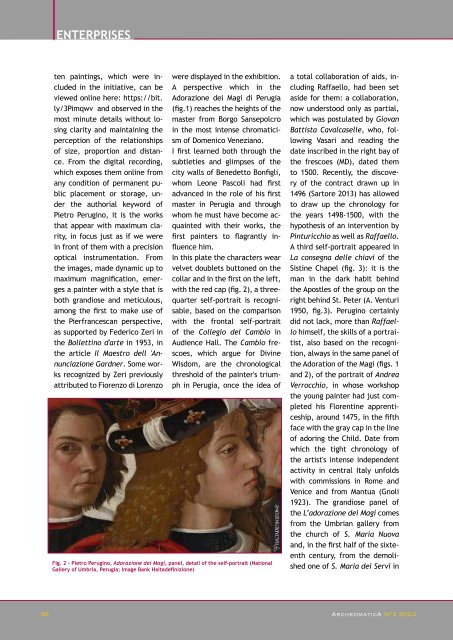Archeomatica_3_2023
ggfdhsd
ggfdhsd
You also want an ePaper? Increase the reach of your titles
YUMPU automatically turns print PDFs into web optimized ePapers that Google loves.
ENTERPRISES<br />
ten paintings, which were included<br />
in the initiative, can be<br />
viewed online here: https://bit.<br />
ly/3Pimqwv and observed in the<br />
most minute details without losing<br />
clarity and maintaining the<br />
perception of the relationships<br />
of size, proportion and distance.<br />
From the digital recording,<br />
which exposes them online from<br />
any condition of permanent public<br />
placement or storage, under<br />
the authorial keyword of<br />
Pietro Perugino, it is the works<br />
that appear with maximum clarity,<br />
in focus just as if we were<br />
in front of them with a precision<br />
optical instrumentation. From<br />
the images, made dynamic up to<br />
maximum magnification, emerges<br />
a painter with a style that is<br />
both grandiose and meticulous,<br />
among the first to make use of<br />
the Pierfrancescan perspective,<br />
as supported by Federico Zeri in<br />
the Bollettino d'arte in 1953, in<br />
the article Il Maestro dell 'Annunciazione<br />
Gardner. Some works<br />
recognized by Zeri previously<br />
attributed to Fiorenzo di Lorenzo<br />
were displayed in the exhibition.<br />
A perspective which in the<br />
Adorazione dei Magi di Perugia<br />
(fig.1) reaches the heights of the<br />
master from Borgo Sansepolcro<br />
in the most intense chromaticism<br />
of Domenico Veneziano.<br />
I first learned both through the<br />
subtleties and glimpses of the<br />
city walls of Benedetto Bonfigli,<br />
whom Leone Pascoli had first<br />
advanced in the role of his first<br />
master in Perugia and through<br />
whom he must have become acquainted<br />
with their works, the<br />
first painters to flagrantly influence<br />
him.<br />
In this plate the characters wear<br />
velvet doublets buttoned on the<br />
collar and in the first on the left,<br />
with the red cap (fig. 2), a threequarter<br />
self-portrait is recognisable,<br />
based on the comparison<br />
with the frontal self-portrait<br />
of the Collegio del Cambio in<br />
Audience Hall. The Cambio frescoes,<br />
which argue for Divine<br />
Wisdom, are the chronological<br />
threshold of the painter's triumph<br />
in Perugia, once the idea of<br />
Fig. 2 - Pietro Perugino, Adorazione dei Magi, panel, detail of the self-portrait (National<br />
Gallery of Umbria, Perugia; Image Bank Haltadefinizione)<br />
a total collaboration of aids, including<br />
Raffaello, had been set<br />
aside for them: a collaboration,<br />
now understood only as partial,<br />
which was postulated by Giovan<br />
Battista Cavalcaselle, who, following<br />
Vasari and reading the<br />
date inscribed in the right bay of<br />
the frescoes (MD), dated them<br />
to 1500. Recently, the discovery<br />
of the contract drawn up in<br />
1496 (Sartore 2013) has allowed<br />
to draw up the chronology for<br />
the years 1498-1500, with the<br />
hypothesis of an intervention by<br />
Pinturicchio as well as Raffaello.<br />
A third self-portrait appeared in<br />
La consegna delle chiavi of the<br />
Sistine Chapel (fig. 3): it is the<br />
man in the dark habit behind<br />
the Apostles of the group on the<br />
right behind St. Peter (A. Venturi<br />
1950, fig.3). Perugino certainly<br />
did not lack, more than Raffaello<br />
himself, the skills of a portraitist,<br />
also based on the recognition,<br />
always in the same panel of<br />
the Adoration of the Magi (figs. 1<br />
and 2), of the portrait of Andrea<br />
Verrocchio, in whose workshop<br />
the young painter had just completed<br />
his Florentine apprenticeship,<br />
around 1475, in the fifth<br />
face with the gray cap in the line<br />
of adoring the Child. Date from<br />
which the tight chronology of<br />
the artist's intense independent<br />
activity in central Italy unfolds<br />
with commissions in Rome and<br />
Venice and from Mantua (Gnoli<br />
1923). The grandiose panel of<br />
the L’adorazione dei Magi comes<br />
from the Umbrian gallery from<br />
the church of S. Maria Nuova<br />
and, in the first half of the sixteenth<br />
century, from the demolished<br />
one of S. Maria dei Servi in<br />
36 36 ArcheomaticA ArcheomaticA N°3 <strong>2023</strong> N°3 <strong>2023</strong>

















